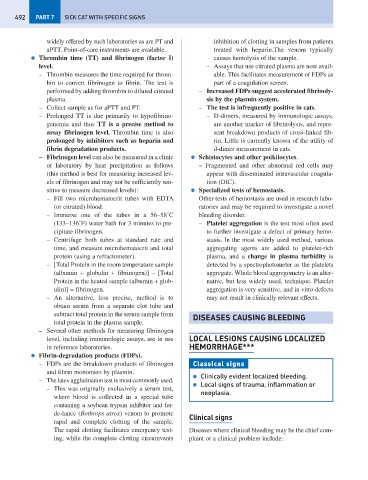Page 500 - Problem-Based Feline Medicine
P. 500
492 PART 7 SICK CAT WITH SPECIFIC SIGNS
widely offered by such laboratories as are PT and inhibition of clotting in samples from patients
aPTT. Point-of-care instruments are available. treated with heparin.The venom typically
● Thrombin time (TT) and fibrinogen (factor I) causes hemolysis of the sample.
level. – Assays that use citrated plasma are now avail-
– Thrombin measures the time required for throm- able. This facilitates measurement of FDPs as
bin to convert fibrinogen to fibrin. The test is part of a coagulation screen.
performed by adding thrombin to diluted citrated – Increased FDPs suggest accelerated fibrinoly-
plasma. sis by the plasmin system.
– Collect sample as for aPTT and PT. – The test is infrequently positive in cats.
– Prolonged TT is due primarily to hypofibrino- – D-dimers, measured by immunologic assays,
genemia and thus TT is a precise method to are another marker of fibrinolysis, and repre-
assay fibrinogen level. Thrombin time is also sent breakdown products of cross-linked fib-
prolonged by inhibitors such as heparin and rin. Little is currently known of the utility of
fibrin degradation products. d-dimer measurement in cats.
– Fibrinogen level can also be measured in a clinic ● Schistocytes and other poikilocytes.
or laboratory by heat precipitation as follows – Fragmented and other abnormal red cells may
(this method is best for measuring increased lev- appear with disseminated intravascular coagula-
els of fibrinogen and may not be sufficiently sen- tion (DIC).
sitive to measure decreased levels): ● Specialized tests of hemostasis.
– Fill two microhematocrit tubes with EDTA Other tests of hemostasis are used in research labo-
(or citrated) blood. ratories and may be required to investigate a novel
– Immerse one of the tubes in a 56–58˚C bleeding disorder.
(133–136˚F) water bath for 3 minutes to pre- – Platelet aggregation is the test most often used
cipitate fibrinogen. to further investigate a defect of primary hemo-
– Centrifuge both tubes at standard rate and stasis. In the most widely used method, various
time, and measure microhematocrit and total aggregating agents are added to platelet-rich
protein (using a refractometer). plasma, and a change in plasma turbidity is
– [Total Protein in the room temperature sample detected by a spectrophotometer as the platelets
(albumin + globulin + fibrinogen)] – [Total aggregate. Whole blood aggregometry is an alter-
Protein in the heated sample (albumin + glob- native, but less widely used, technique. Platelet
ulin)] = fibrinogen. aggregation is very sensitive, and in vitro defects
– An alternative, less precise, method is to may not result in clinically relevant effects.
obtain serum from a separate clot tube and
subtract total protein in the serum sample from DISEASES CAUSING BLEEDING
total protein in the plasma sample.
– Several other methods for measuring fibrinogen
level, including immunologic assays, are in use LOCAL LESIONS CAUSING LOCALIZED
in reference laboratories. HEMORRHAGE***
● Fibrin-degradation products (FDPs).
– FDPs are the breakdown products of fibrinogen Classical signs
and fibrin monomers by plasmin.
● Clinically evident localized bleeding.
– The latex agglutination test is most commonly used.
● Local signs of trauma, inflammation or
– This was originally exclusively a serum test,
neoplasia.
where blood is collected in a special tube
containing a soybean trypsin inhibitor and fer-
de-lance (Bothrops atrox) venom to promote
Clinical signs
rapid and complete clotting of the sample.
The rapid clotting facilitates emergency test- Diseases where clinical bleeding may be the chief com-
ing, while the complete clotting circumvents plaint or a clinical problem include:

